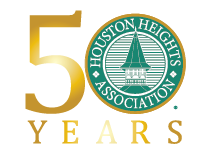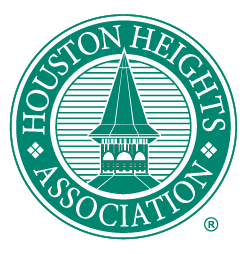History of the heights
History
History Overview
The decade of the 1890s was an exciting period of development for Americans. Towns were becoming cities; cities were expanding. This was especially true in Texas, where speculators were drawn from other states. The Houston area attracted thousands of these adventurers, and it was in this climate that Houston Heights began.
As early as 1886, Oscar Martin Carter, a self-made millionaire who had business interests in Nebraska and Colorado, brought to Houston a utopian vision for the approaching twentieth type of town, a planned community where successful entrepreneurs and working people alike could live and work, in health and safety, as neighbors. Compared to Houston, a city plagued by yellow fever and devastating annual floods, Carter chose the ideal spot for his new community. Houston Heights, with an elevation 23 feet higher than downtown Houston, a natural sandy soil, rich vegetation, mature trees and artesian water sources, promised a sanctuary of health and well being.
The land O.M. Carter and his Omaha and South Texas Land Company developed had long been an important area to the city of Houston. This section of Southeastern Texas was first inhabited by Indians of the Coastal Plains. Although a Spaniard had visited the area in the early 16th century, it was not until 1745 that the French from New Orleans and the Spanish began to vie for control of the region. At that time, the area that included much of Houston Heights was controlled by Chief Canos of the Orcoquisacs. Chief Canos successfully played the two European powers against one another for many years.
O.M. Carter had convinced his eastern investors that Houston was destined for growth and the ideal place to invest heavily. Not only did Carter realize that Houston would attract major industries and thus experience. Population growth due to the jobs created by those industries, but he planned for many of the industries to locate in his planned development. He also knew that there would be a great need for housing and he wanted his development to provide the opportunity for home ownership.
Carter’s vision included a transportation system that would bring passengers four miles from Houston to his planned community, a considerable distance in those days. However, in 1890, when most cities the size of Houston already had electric streetcar lines, Houston only had two mule-drawn systems. He arranged for the purchase and electrification of both systems, thus guaranteeing electric streetcars to Houston Heights. His investment gave potential investors the confidence to believe in his dream and invest in his totally planned community. It was also a very profitable venture, since the city was destined for tremendous growth as well.
By 1891, Carter attracted a corps of investors who set up the Omaha and South Texas Land Company. He even convinced some of them to give not just their money, but to live their lives in his utopian city. Carter recognized the desire of the growing middle class to move away from the noise and dirt of the crowded city. The company purchased 1,756 acres of land, and made over $500,000 worth of improvements, including utilities, streets and alleys, as well as parks and schools. The blocks were carefully arranged, some principal streets were covered with shell, and a waterworks system was established. Scattered open spaces supplemented the 60 foot- wide esplanade on Heights Boulevard. The trees and other natural features that now line the streets were planted during that early period of development. Carter also built a commercial strip at 19th and Ashland Streets and arranged for stores to open there to serve new residents. As was common in most promotional towns, he built a grand hotel (destroyed by fire, 1915) where prospective buyers could stay when they inspected the area.
The founding fathers also built a series of grand Victorian homes along Heights Boulevard, a broad, tree-lined central thoroughfare patterned after Commonwealth Avenue in Boston. Major industrial and commercial concerns were also attracted to Houston Heights by Carter and his associates before the turn of the century, thus completing his plan to develop a totally planned community in which to live and work.
From the outset, Carter planned Houston Heights as a modest community. There were a few land dealers, such as William A. Wilson, who acted as investors and developers in the area. But, in general, Carter sought to prevent speculation. His advertisements and his methods of promotion do not appear to have been aimed at the very wealthy, but at the growing class of white-collar workers, young professionals, and the skilled craftsmen of the working class. His philosophy has been maintained in practice by the residents over the years, whether consciously or not. The social and economic make-up of the present day Houston Heights probably is quite similar to that of 1915. The early occupants of the large, fanciful homes along the Boulevard were often doctors, lawyers or real estate professionals.
New industries directly related to oil, gas and shipping developed at the turn of the century in Houston and the Gulf Coast. Carter planned a portion of Houston Heights to attract some of that industry. Cotton mills, textile factories and oil refineries cropped up in the area during the initial years of development. One factory, the Oriental Textile Mill, even developed an area of about four blocks near the plant as a “Factory Village,” a clustering of small houses for the workers.
The greater portion of Houston Heights was residential, however, and as it grew, it was not uncommon for a new resident to use the skills of his trade to build a home for his own family in addition to those he built professionally. Smaller, more modest cottages were built by resident-carpenters and other members of the building trade.
The green, open spaces in which children could play, the schools, the churches and the social and civic clubs were all necessary elements. One of the most important was the Houston Heights Woman’s Club. It was established in 1900 by the merger of several other, more specialized groups. The club built a small bungalow style clubhouse at 1846 Harvard Street in 1912, which still serves as the headquarters for the group today. The purposes of the club included social work and charity, as well as educational instruction and cultural events. In addition to the Woman’s Club, there were several more exclusive groups in the area with which the residents, particularly women, could affiliate.
Education was a very high priority among the leaders of Houston Heights from the beginning. Two elementary schools were constructed by 1900 to serve the northern and eastern sections of the community, and a high school was built in 1904. A few additions were made to these schools while Houston Heights existed as a separate municipality, but major new construction did not occur until after annexation of the town by Houston. New schools were built in the 1920s and a library was constructed at 1302 Heights Boulevard. This facility still serves. The city of Houston grew tremendously following World War 1, partly because of the deepening of the ship channel and expansion of the petroleum and chemical industries. A major result of the expansion was the extension of several major streets and highways and, in later years, the construction of new interstate highway systems. The road and transportation expansions in the 1940s gave urban residents greater mobility to move to the suburbs and abandon the older, established neighborhoods. As a result of the exodus to the suburbs, Houston Heights also began to decline. Most larger homes were transformed into multifamily apartments or were neglected and deteriorated and eventually demolished.
By 1970, the perception of the Heights was that of poverty. The pattern of promotion, booming growth, uncertainty and decline that was experienced by Houston Heights is similar to what happened to most inner-city neighborhoods. More commercial and industrial interests began to creep into the area after World War 11, due to lack of zoning laws.
In 1973, residents and business owners organized the Houston Heights Association to work together toward maintaining the quality of life desired and toward preserving the historic fiber of the community. This renewed vitality has been attracting new residents, many of whom are the children of those people who moved to the suburbs long ago. In contrast to 100 years ago, the majority of these young, new residents are not moving to Houston Heights to build new homes but to restore the historic homes built by others. They are part of the national trend to buy an old house with all its charm and architectural distinction and restore it. Young professionals are also seeking the convenience of close-in living — only a short distance from work, cultural centers and restaurants. Once again, Houston Heights is developing a firm sense of identity and camaraderie not much different from that found in the community created by O. M. Carter many years ago.
Who Are The Founders of Houston Heights?
In 1886 Oscar Martin Carter, a self-made millionaire who had business interests in Nebraska and Colorado, brought to Houston his utopian vision for the 20th century. Carter’s dream was to build a new type of town, a planned community where people could live and work in health and safety. Houston was a city plagued by yellow fever and devastating annual floods. Carter chose the Heights as an ideal spot for his new community. Houston Heights, with an elevation 23 feet higher than downtown Houston, a natural sandy soil, rich vegetation, mature trees, and artesian water sources, promised a sanctuary of health and well-being. Carter convinced his Eastern investors that Houston was destined for growth and the ideal place to invest heavily. Carter attracted his corps of investors who set up the Omaha and South Texas Land Company. Not only did they invest, but many also lived in this utopian city. The company purchased 1,756 acres of land and made over $500,000 worth of improvements, including utilities, streets and alleys, as well as parks and schools. The blocks were carefully arranged, along with the planting of trees and natural features that now line the streets. Along with his other accomplishments, Carter built a commercial strip at 19th and Ashland to serve the new residents.
D. D. Cooley came to Houston in 1890 as the general manager in charge of development for the Omaha and South Texas Land Company. Cooley owned and lived in one of the first residences built on Heights Boulevard; he was also one of the original group of investors in the Houston Heights. His home, built in 1893, was to serve as an example of the type of house to be built on the Boulevard. The Cooley family was extremely active socially; Mrs. Cooley even donated the land where the Houston Heights Woman’s Club was erected in 1912. Education was of foremost importance to Cooley, and he was instrumental in establishing some of the first schools in the Heights, including one for Black children at a time in the country’s history when education was not only segregated but almost entirely out of reach for Black families.
Silas Wilkins bought the first lots in 1893. He was a carpenter for the Omaha and South Texas Land Company who had helped ready the land for the residents. Shortly thereafter, he built a home at 1541 Ashland Street and later became the second postmaster of Houston Heights after the incorporation of the Houston Heights as a “village” in 1896 (Houston Heights celebrated its 100th anniversary of incorporation on July 1.)
William G. Love was elected the first mayor. He served from the incorporation as a village in 1896 until 1899. Love’s greater service to the Heights, however, was as its legal advisor. He was also appointed District Attorney for Houston and Galveston counties in 1907, and was elected to the position the next year, serving until 1910. The large, Queen-Anne style house at 1505 Heights Boulevard was his home until his death in 1926.
John Milroy joined Carter in 1893 and was influential in selling lots and recruiting residents into the Heights. First living at 1602 Harvard Street, he and his family moved in 1897 to the large home at 1102 Heights Boulevard – today listed as a Registered Texas Historical Landmark. For 20 years, Milroy acted as general agent of the Houston Heights Office of Carter’s company, in charge of all lands owned by Carter in Texas. He also served 8 terms as mayor of Houston Heights (1899 to 1907). Milroy died only a few months after its annexation into Houston in 1918.
Milroy was followed by David Barker, who was mayor from 1907 to 1913. During Barker’s administration, Heights Boulevard and several other streets were paved, schools were constructed, and the first fire station was built. Houston Heights’ dry ordinance, which banned the sale of alcoholic beverages in large portions of the community, was passed on September 25, 1912. This ordinance remains in force today. Barker’s home at 121 E. 16th Avenue received a Registered Texas Historical Landmark designation in 1991.
Barker was succeeded in April 1913 by Robert F. Isbell, who lived at 639 Heights Boulevard. (In The History of Houston Heights by Sister M. Agatha, we read that Isbell resigned his position in August,1914 to move his family to Taft, Texas for a better job opportunity. He was accidentally shot and killed on February 19, 1920. His widow returned to their Heights Boulevard home where she continued to live for many years.)
James B. Marmion served as the last mayor of the Houston Heights (1914-1918). His administration spawned a new fire station, city hall, and jail at 12th and Yale. During his administration, residents concluded that they could no longer provide enough tax revenue to properly educate their children through the local school system. This acknowledgment directly led to the decision of annexation by the City of Houston in 1918.









